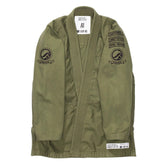Importance of Gi Colors in Brazilian Jiu-Jitsu: Tradition, Identity, and Rules
In the dynamic and evolving world of Brazilian Jiu-Jitsu (BJJ), few things are as instantly recognizable as the iconic BJJ Gi. The Gi is not just a uniform. It is a symbol of discipline, respect and identity within the art. Functionality and design of BJJ Gi have evolved over time. However, one element that continues to spark interest, debate and even confusion among practitioners is the color of the Gi. The color of a BJJ Gi may seem like a superficial detail. But it holds profound cultural, psychological, competitive and even regulatory significance.
In this comprehensive article, we will explore the importance of Gi colors in Brazilian Jiu-Jitsu. Moreover, we will examine the historical roots, traditional meanings, practical considerations, and modern interpretations behind different Gi colors. It does not matter whether you are a seasoned black belt or a curious beginner looking to buy your first BJJ Gi. Understanding Gi colors can deepen your appreciation of this powerful martial art.
The Traditional BJJ Gi Colors: White, Blue and Black
When Brazilian Jiu-Jitsu was formalized as a sport, Gi colors were limited to three main shades i.e. white, blue, and black. These colors are still the most commonly accepted in most academies and competitions today.
1- White Gi – The Classic and Pure
The white BJJ Gi is the original and most traditional color in Brazilian Jiu-Jitsu. It is rooted in the traditions of Japanese martial arts such as Judo. The white Gi represents purity, humility and the beginner’s mindset. Wearing a white Gi often reflects a practitioner’s commitment to the roots of the art.
Significance of the White Gi:
- Represents tradition and respect for the martial roots of BJJ.
- Symbolizes discipline, cleanliness and a humble mindset.
- Required in many formal dojos and traditional academies.
- Often preferred by instructors and purists of the sport.
2- Blue Gi – The Practical Alternative
The blue BJJ Gi was introduced to offer an alternative to the traditional white, especially in competition settings. It became popular due to its resistance to visible stains and wear during intense training.
Significance of the Blue Gi:
- Offers a practical, durable look that hides sweat and mat burns.
- Approved by major competitions like IBJJF (International Brazilian Jiu-Jitsu Federation).
- A favorite among practitioners who want a balance between tradition and modernity.
- Helps referees distinguish between opponents during matches when the other is wearing a white or black Gi.
3- Black Gi – The Symbol of Power and Style
Black BJJ Gi was introduced later. However, the black Gi has gained immense popularity for its sharp, authoritative appearance. While not as traditional as white, black has become a favorite for both training and competition.
Significance of the Black Gi:
- Conveys a sense of strength, seriousness and focus.
- Often worn by advanced practitioners or instructors.
- Stylish and sleek, appealing to those who prefer a modern aesthetic.
- Also allowed in most official tournaments and BJJ gyms worldwide.
Colored Gis Beyond the Tradition: Gray, Navy, Red, and More
As Brazilian Jiu-Jitsu evolved and spread globally, so did the creativity of its community. Today, practitioners can find BJJ Gis in colors ranging from gray, navy and army green to red, pink and even camo. While these colors are generally accepted for training, they come with considerations.
Academy Policies
Many BJJ academies have strict uniform policies. These academies often allow only white, blue or black Gis. Wearing a non-traditional color may be considered disrespectful or unprofessional unless explicitly permitted. Always check your academy’s guidelines before wearing a colored Gi.
Competition Rules
The IBJJF, the governing body for many BJJ tournaments, allows only white, royal blue or black Gis. This regulation helps referees distinguish competitors clearly. Hence, it helps in maintaining a level of formality in matches.
Wearing non-approved colors like red, gray, or camouflage in official IBJJF competitions can disqualify you from participation.
Expression and Identity
Outside of competitions, colored Gis are increasingly seen as a form of self-expression. Brands like Shoyoroll, Tatami and even newer names like Novakik BJJ are creating limited-edition, stylish Gis in non-traditional colors. These colors reflect individual personalities or affiliations with teams.
Psychological Impact of Gi Colors
Colors play a powerful role in psychology. And in a sport like Brazilian Jiu-Jitsu, the psychological edge can be crucial.
- White reflects humility and respect, often creating a calm and composed aura around the practitioner.
- Black can be perceived as intimidating and powerful, possibly giving the wearer a psychological edge.
- Blue conveys a stable, trustworthy image—ideal for showing quiet confidence.
Some practitioners claim that wearing a black or darker Gi makes them feel more focused and aggressive. However, others believe lighter colors keep them more relaxed and fluid. While science has not confirmed these effects conclusively, personal preference and belief often play a strong role in performance.
Gi Color and Team Affiliation
In some academies, Gi colors may represent different ranks, teams or affiliations. For example:
- Certain academies may assign specific Gi colors to higher belts (e.g., only brown belts and above can wear black Gis).
- Some teams produce custom team-colored Gis to build a sense of unity and pride.
- Special edition Gi and No-Gi uniforms may reflect anniversaries, seminar events or exclusive club memberships.
This adds another layer of meaning to the color choice—not just style, but identity and allegiance.
Kids and Gi Colors in BJJ
In youth Brazilian Jiu-Jitsu, color flexibility is even more pronounced. Many academies allow children to wear fun colors like pink, purple, red or camo to keep them engaged and excited about training. It is not uncommon to see kids in rainbow Gis during youth classes.
The goal here is to make BJJ fun, inclusive and motivating, especially for beginners who may associate bright colors with positivity and excitement.
Shop Youth BJJ Gi
Fashion, Branding and Marketing in Gi Colors
From an industry perspective, Gi color trends are heavily influenced by fashion and marketing. Leading BJJ brands have successfully turned Gi releases into fashion drops. Thus, generating hype and anticipation for limited-edition colors and patches.
This marketing approach boosts sales. But it also allows BJJ practitioners to express their personality through unique gear. Hence, fostering deeper emotional connections with their training attire.
A brand like Novakik BJJ, for example, may release ranked rash guards or Gis in stylish yet competition-legal colors, blending function, performance and personal flair.
Final Thoughts: Choosing the Right BJJ Gi Color for You
In the world of Gi and No-Gi Brazilian Jiu-Jitsu, the color of your BJJ Gi is more than a stylistic choice. It is a blend of tradition, personality, competition standards and cultural respect. It does not matter whether you choose the pristine white, the bold black, the standard blue or a flashy red or camo design. Your Gi color can speak volumes about your attitude toward the art.
When choosing your next Gi, consider:
- Your academy’s dress code
- Whether you plan to compete
- Your rank and training experience
- Your personal taste and mindset
Always remember:
The color of the Gi does not determine your skill. But it does reflect your understanding, respect and representation of the beautiful and powerful art that is Brazilian Jiu-Jitsu.







